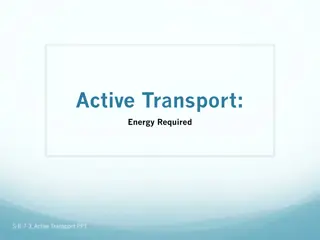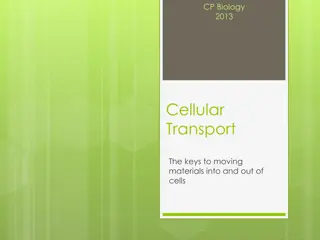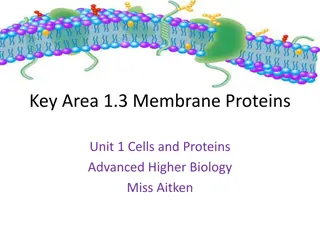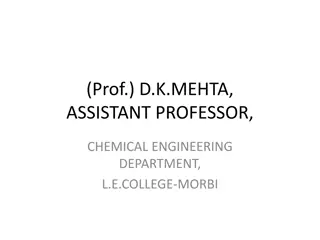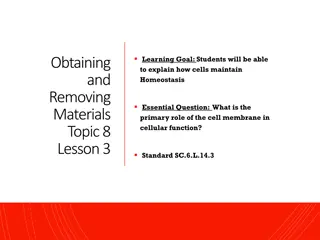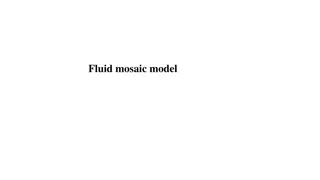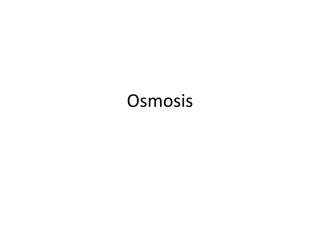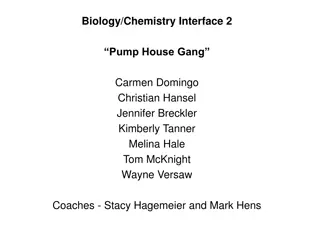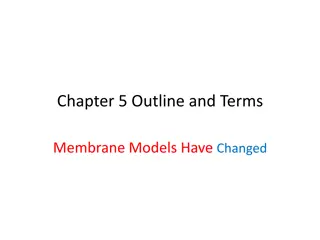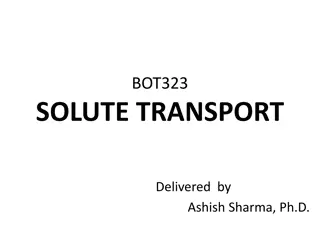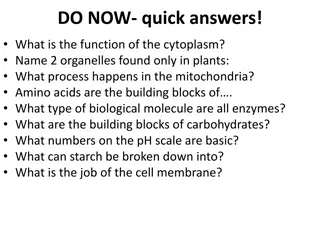Understanding Cell Membrane Transport: Diffusion and Facilitated Diffusion
Cell membrane transport plays a crucial role in maintaining cellular functions by regulating the movement of substances across the membrane. Diffusion, a passive transport process, allows molecules to move from areas of high concentration to low concentration without energy expenditure. Within diffusion, there are simple diffusion and facilitated diffusion pathways. Simple diffusion involves the movement of lipid-soluble substances through the lipid bilayer, while lipid-insoluble substances use protein channels. Facilitated diffusion further divides into channel-mediated and carrier-mediated processes, each employing specific proteins to aid in substance transport. Channel proteins provide a pathway for polar compounds to cross the membrane, while carrier proteins bind and transport specific substances. Understanding these mechanisms is essential for comprehending how cells maintain their internal environments and interact with the external environment.
Download Presentation

Please find below an Image/Link to download the presentation.
The content on the website is provided AS IS for your information and personal use only. It may not be sold, licensed, or shared on other websites without obtaining consent from the author. Download presentation by click this link. If you encounter any issues during the download, it is possible that the publisher has removed the file from their server.
E N D
Presentation Transcript
Transport across Cell Membrane Transport across cell membrane is classified into four ways: 1.Diffusion (Passive Transport) 2. Osmosis 3. Active Transport 4. Vesicular Transport. Cell membrane acts as a barrier to most, but not all molecules. Cell membranes are semi-permeable barrier separating the inner cellular environment from the outer cellular environment. Since the cell membrane is made up of a lipid bilayer with proteins attached on the surface and also passing through the cell membrane, there is possibility of transport across this membrane. All lipid soluble substances can easily and freely diffuse in and out, e.g. O2 and CO2. Water soluble substances like ions, glucose and macromolecules should find a special way of transport with the help of integral and trans- membrane proteins which act as binding sites, channels and gates to facilitate movement.
Diffusion (Passive Transport) It is the net movement of a substance (liquid or gas) from an area of higher concentration to lower concentration without expenditure of energy is called diffusion. Diffusion can be further divided as follows: A. Simple diffusion B. Facilitated diffusion. A. Simple Diffusion: It is further classified into two categories: i. Diffusion of lipid soluble substance through lipid bilayer. ii. Diffusion of lipid insoluble substance through protein channels. i. Diffusion of Lipid Soluble Substance through the Lipid Bilayer: Substance like oxygen and carbon dioxide and alcohols are highly lipid soluble and dissolve in the layer easily and diffuse through the membrane. The rate of diffusion is determined by the solubility of the substance. For example, exchange of gases in the lungs. ii. Diffusion of Lipid Insoluble Substance through Protein Channels: This is possible through either selective permeability of protein channel or through gated channels
Facilitated diffusion 1. Channel mediated 2. Carrier mediated Both differs on the type of protein used Channel proteins The interior "passageway" of channel proteins have evolved to provide a low energetic barrier for transport of substances across the membrane through the complementary arrangement of amino acid functional groups (of both backbone and side-chains). Passage through the channel allows polar compounds to avoid the nonpolar central layer of the plasma membrane that would otherwise slow or prevent their entry into the cell. While at any one time significant amounts of water crosses the membrane both in and out the rate of individual water molecule transport may not be fast enough to adapt to changing environmental conditions. For such cases Nature has evolved a special class of membrane proteins called aquaporins that allow water to pass through the membrane at a very high rate.
Channel proteins are either open at all times (leak channels)or they are gated (require stimulus to open) The gate controls the opening of the channel. Various mechanisms may be involved in the gating mechanism. For instance, the attachment of a specific ion or small molecule to the channel protein may trigger opening. Changes in local membrane "stress" or changes in voltage across the membrane may also be triggers to open or close a channel. Carrier Proteins Another type of protein embedded in the plasma membrane is a carrier protein. This aptly named protein binds a substance and, in doing so, triggers a change of its own shape, moving the bound molecule from the outside of the cell to its interior; depending on the gradient, the material may move in the opposite direction. Carrier proteins are typically specific for a single substance. This selectivity adds to the overall selectivity of the plasma membrane. Channel and carrier proteins transport materials at different rates. Channel proteins transport much more quickly than do carrier proteins. Channel proteins facilitate diffusion at a rate of tens of millions of molecules per second, whereas carrier proteins work at a rate of a thousand to a million molecules per second
Active Transport Transport mechanisms require the use of the cell s energy, usually in the form of adenosine triphosphate (ATP). Moving substances up their electrochemical gradients requires energy from the cell. Active transport uses energy stored in ATP to fuel this transport. Active transport of small molecular-sized materials uses integral proteins in the cell membrane to move the materials: These proteins are analogous to pumps. If a substance move into the cell against its concentration gradient that is, if the concentration of the substance inside the cell is greater than its concentration in the extracellular fluid (and vice versa) the cell must use energy to move the substance. Some active transport mechanisms move small- molecular weight materials, such as ions, through the membrane. Other mechanisms transport much larger molecules.
Moving Against a Gradient To move substances against a concentration or electrochemical gradient, the cell must use energy. This energy is harvested from ATP generated through the cell s metabolism. Active transport mechanisms, collectively called pumps, work against electrochemical gradients. Small substances constantly pass through plasma membranes. Active transport maintains concentrations of ions and other substances needed by living cells in the face of these passive movements. Active transport mechanisms depend on a cell s metabolism for energy, they are sensitive to many metabolic poisons that interfere with the supply of ATP. Two mechanisms exist for the transport of small-molecular weight material and small molecules. Primary active transport moves ions across a membrane and creates a difference in charge across that membrane, which is directly dependent on ATP. Secondary active transport describes the movement of material that is due to the electrochemical gradient established by primary active transport that does not directly require ATP.
Carrier Proteins for Active Transport An important membrane adaption for active transport is the presence of specific carrier proteins or pumps to facilitate movement: there are three types of these proteins or transporters. A uniporter carries one specific ion or molecule. A symporter carries two different ions or molecules, both in the same direction. An antiporter also carries two different ions or molecules, but in different directions. All of these transporters can also transport small, uncharged organic molecules like glucose. These three types of carrier proteins are also found in facilitated diffusion, but they do not require ATP to work in that process. Some examples of pumps for active transport are Na+-K+ ATPase, which carries sodium and potassium ions, and H+-K+ ATPase, which carries hydrogen and potassium ions. Both of these are antiporter carrier proteins. Two other carrier proteins (both are pumps) are Ca2+ ATPase and H+ ATPase, which carry only calcium and only hydrogen ions, respectively.
A uniporter carries one molecule or ion. A symporter carries two different molecules or ions, both in the same direction. An antiporter also carries two different molecules or ions, but in different directions.
In primary active transport, the energy is derived directly from the breakdown of ATP. Often times, primary active transport functions to transport sodium and potassium ions allows secondary active transport to occur (discussed in the section below). The second transport method is still considered active because it depends on the use of energy from the primary transport. Ion-pumps may be of two types: (i) Electro neutral pumps (ii) Electro genic pumps. Electro neutral pumps are those which are associated with transport of ions with no net movement of charge across the membrane. For example H+/K+- ATPase of some animal cells, pumps out one H+ for each K+taken in with no net movement of charge. Therefore, it is an electro neutral pump. Electro genic pumps on the other hand, transport ions involving net movement of charge across the membrane. One of the most important pumps is the sodium-potassium pump (Na+-K+ ATPase), which maintains the electrochemical gradient (and the correct concentrations of Na+ and K+) in living cells. The sodium-potassium pump moves K+ into the cell while moving Na+ out at the same time, at a ratio of three Na+ for every two K+ ions moved in. The Na+-K+ ATPase exists in two forms, depending on its orientation to the interior or exterior of the cell and its affinity for either sodium or potassium ions. The process consists of the following six steps.
Electrogenic pumps (H+-ATPase, Na+/K+ ATPase) Na+/K+ ATPase ATPase enzyme oriented towards the interior of the cell, the carrier has a high affinity for sodium ions. Three sodium ions bind to the protein. ATP is hydrolyzed by the protein carrier and a low-energy phosphate group attaches to it. As a result, the carrier changes shape and re-orients itself towards the exterior of the membrane. The protein s affinity for sodium decreases and the three sodium ions leave the carrier. The shape change increases the carrier s affinity for potassium ions, and two such ions attach to the protein. Subsequently, the low-energy phosphate group detaches from the carrier. With the phosphate group removed and potassium ions attached, the carrier protein repositions itself towards the interior of the cell. The carrier protein, in its new configuration, has a decreased affinity for potassium, and the two ions are released into the cytoplasm. The protein now has a higher affinity for sodium ions, and the process starts again.
At this point, there are more sodium ions outside of the cell than inside and more potassium ions inside than out. For every three ions of sodium that move out, two ions of potassium move in. This results in the interior being slightly more negative relative to the exterior. This difference in charge is important in creating the conditions necessary for the secondary process. The sodium-potassium pump is, therefore, an electrogenic pump (a pump that creates a charge imbalance), creating an electrical imbalance across the membrane and contributing to the membrane potential. H+-ATPase, H+-Ppase (H+-translocating inorganic pyrophosphatase) and Ca2+-ATPase are most common electro genic pumps in plant cells and their direction is outward.
Proton-ATPase Pumps (H+-ATPases): These pumps are also known as P-type ATPases and are found in plasma membrane, tonoplast and possibly other cell membranes. These are structurally distinct and operate in reverse of F-type ATPases i.e., they hydrolyse ATP instead of synthesizing it (ATPases of mitochondria and chloroplast are also known as F-type ATPases) This enzyme protein is a single chain polypeptide with 10 hydrophobic trans membrane segments or domains . These segments are joined by hydrophilic loops which project in cytosol and cell wall (apoplast). The ATP binding site is believed to be an aspartic acid residue (D) situated on loop connecting 4th and 5th segments towards cytosilic side. Hydrolysis of ATP causes conformational change in the protein and one H+ ion is transported from cytosol to outside across the plasma membrane.
(i)Vacuolar H+-ATPases (Plants) These are strongly inhibited by NO3 . Two protons (2H+) are trans located for each molecule of ATP hydrolysed. Resemble structurally to F-type ATPases of mitochondria and can be separated into two complexes analogous to F0 and F1, out unlike the former are not inhibited by oligomycin or azides. (ii) Proton-pyrophosphatases (H+ PPases) (Plants) There are mainly found in tonoplasts but may also occur in membrane of Golgi- bodies They pump protons into the lumen of vacuole and Golgi-cisternae. These pumps appear to work in parallel with vacuolar ATPases to create protons gradient across the tonoplast. This enzyme protein consists of a single polypeptide chain with molecular mass of 80 kD and utilizes energy from hydrolysis of inorganic pyrophosphate (PPi). Free energy released by hydrolysis of PPi is less than that obtained from hydrolysis of ATP. Vacuolar H+ PPase transport only one H+ per PPi molecule hydrolysed
(iii) Calcium Pumping ATPases (Ca2+-ATPases): These are found in plasma membrane, tonoplast and possibly other cell membranes such as those of chloroplasts and ER. These pumps couple hydrolysis of ATP with translocation of Ca2+ across the membrane
Secondary active transport Secondary active transport brings sodium ions, and possibly other compounds, into the cell. As sodium ion concentrations build outside of the plasma membrane because of the action of the primary active transport process, an electrochemical gradient is created. If a channel protein exists and is open, the sodium ions will be pulled through the membrane. This movement is used to transport other substances that can attach themselves to the transport protein through the membrane. Many amino acids, as well as glucose, enter a cell this way. This secondary process is also used to store high-energy hydrogen ions in the mitochondria of plant and animal cells for the production of ATP. The potential energy that accumulates in the stored hydrogen ions is translated into kinetic energy as the ions surge through the channel protein ATP synthase, and that energy is used to convert ADP into ATP.
Secondary Active TransportSymport and Antiport: A large number of nutrients are transported across the cell membranes against their chemical potential or electro chemical potential gradients by secondary active transport mechanism that does not utilize energy liberated by hydrolysis of ATP directly but indirectly through the energy stored in proton- electrochemical potential gradient across the membrane or proton motive force. The electrogenic proton-ATPase (H+-ATPase) pumps serve as proton translocating carrier proteins and free energy of hydrolysis of ATP is conserved in the form of proton gradient across the membrane (more protons accumulating on outer side). This proton gradient together with normal membrane potential contributes to proton electrochemical potential gradient or a proton motive force which tends to move protons back across the membrane through specific carrier proteins located elsewhere on the same membrane. When protons return back to cytosolic side, the proton motive force generated by electro genic H+ transport can be utilized to drive transport of other solute molecules or ions against their chemical or electrochemical potential gradient through the same carrier protein through which H+ is returning back to cytosol. This is called as secondary active transport and because ions or molecules of two different substances (H+ and other solute) are being transported at the same time through the some carrier protein, this process of solute transport is also called as co transport mechanism.
Secondary active transport or cotransport mechanism is of two types: (i) Symport and (ii) Antiport Symport: When influx of protons is coupled with movement of other solute in the same direction, the cotransport mechanism is celled as symport and the carrier protein is called as symporter Example: Glucose symporterSGLT1, which co-transports one glucose (or galactose) molecule into the cell for every two sodium ions it imports into the cell. The Na+ flow down their concentration gradient while the glucose molecules are transported against their concentration gradient into the cell. Later the Na+ is pumped back out of the cell by the Na+ -K+ ATPase. Antiport: When influx of protons is coupled with efflux of other solute, the cotransport mechanism is called as antiport and the carrier protein involved is called as antiporter. Example: the sodium-calcium exchanger or antiporter, which allows three sodium ions into the cell to transport one calcium out.
Ion Channel A typical ion channel, which fluctuates between closed and open conformations The channel protein shown here in cross section forms a hydrophilic pore across the lipid bilayer only in the open conformational state. Polar groups are thought to line the wall of the pore, while hydrophobic amino acid side chains interact with the lipid bilayer (not shown). The pore narrows to atomic dimensions in one region (the selectivity filter), where the ion selectivity of the channel is largely determined
The main types of stimuli that are known to cause ion channels to open are a change in the voltage across the membrane (voltage-gated channels), a mechanical stress (mechanically gated channels), or the binding of a ligand (ligand-gated channels). The ligand can be either an extracellular mediator specifically, a neurotransmitter (transmitter-gated channels) or an intracellular mediator, such as an ion (ion-gated channels) or a nucleotide (nucleotide-gated channels). The activity of many ion channels is regulated, by protein phosphorylation and dephosphorylation.




